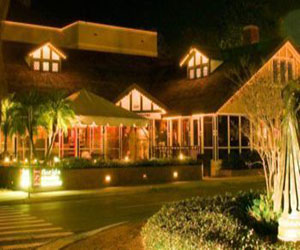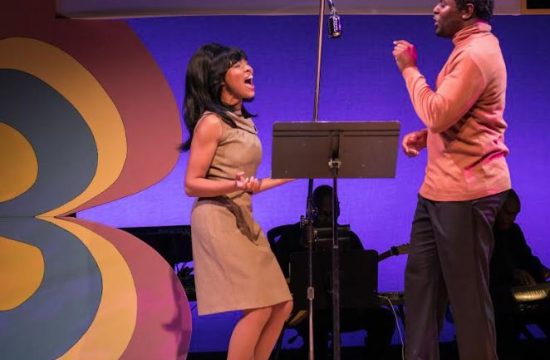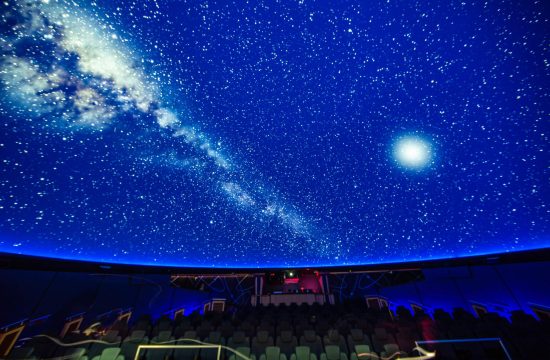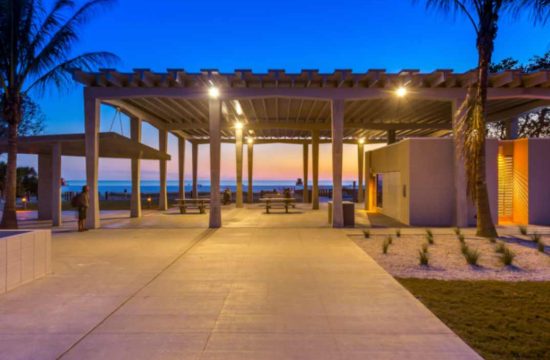The latest news and events, Our Town Sarasota.com
HISTORICAL WALKING TOUR
- Sarasota’s Civic Center and Theatre Arts District Municipal Auditorium, 801 N. Tamiami Trail – Designed by well-known local architect omas Reed Martin and opened in 1938, the auditorium was the first structure in the Civic Center, a WPA-funded public recreation and cultural area between Blvd. of the Arts and 10th Street west of North Tamiami Trail. An auditorium is one of only a few surviving examples of Art Deco architecture in Sarasota. Shuffleboards, tennis courts, and lawn-bowling greens were constructed to the north. Parking lots have replaced all but the lawn-bowling greens. The auditorium is listed in the National Register of Historic Places. (C. 1940) 1 (C. 1941)
- Sarasota County Visitors Center and History Center Museum, 701 N. Tamiami Trail – is was built as the City of Sarasota’s first and only public library building in 1941. When the library’s collection outgrew its space, the city joined with the county to create a countywide library system. In 1976, the collection moved to Selby Library at 1001 Boulevard of the Arts, which became the main library in the county system. Sarasota County Historical Resources moved into the building that same year. In 2007 Historical Resources (now called the Sarasota County History Center) moved to 6062 Porter Way, opening up the Chidsey building for its new use as a visitor information center and history center museum. Hours: 10 a.m.-4 p.m. Monday-Saturday; noon-3 p.m. Sunday.
- Pagoda Building, 655 N. Tamiami Trail – Built by the Greater Sarasota Chamber of Sarasota Garden Club, 1131 Boulevard of the Arts – Garden Club members had supervised and maintained the landscaping of the Civic Center long before they opened their own building in 1960. In the “Sarasota School” style, architect John Crowell sought to make the Garden Club’s home compatible with the nearby Chamber of Commerce “pagoda.” A tool shed built the following year was patterned after Japanese garden houses. 3 4 5
- Art Center Sarasota, 707 N. Tamiami Trail – Opened in 1949 by the Sarasota Art Association, this building has been home to many area artists of regional and national fame. Its exhibits focus on the works of visual artists of Florida. An outdoor sculpture garden was created in 1996. 2 Commerce in 1956, the center was designed by Victor Lundy, a contributor to the Sarasota School of Architecture. Architects of the “School” combined influences of the European modernist movement with local materials and the desire to minimize the distinction between interior and exterior spaces. With the advent of air conditioning, their large moveable glass “walls” and jalousie windows and doors made these buildings impractical. Lundy broke with some of his peers’ practices and imported the roof tiles from Japan instead of using local materials. He reportedly selected his building style because he was influenced by a Japanese garden sculpture near the pond to the south of the building. (C. 1975) (C. 1920) (C. 1910) (C. 1920) (C. 1920)
- Bijou Café, 1287 First Street – is building began as a filling station in the 1920s. In the 1970s it was converted into an artist’s studio and most recently extensively renovated as a popular café. Restaurant building (formerly DJ’s), 1296 First Street – Local businessman I. R. Burns constructed this building in 1925, at the height of the Florida Land Boom, in an area called “Realtors Row.” Over the years, it housed a variety of businesses, professional offices and city departments. In the 1980s it became a restaurant. 13 14
- Sarasota Opera House, 57 N. Pineapple Avenue – Former Sarasota mayor A. B. Edwards built this theater in 1926. e groundlevel storefronts housed a variety of businesses, while the theater hosted vaudeville, opera and silent movies. Apartments were rented out on the third floor. Will Rogers and the Ziegfeld Follies performed here. e local press described the building as a 15
- Florida Studio Theatreeater, 1241 N. Palm Avenue – Woman’s Club of Sarasota erected this National Register-listed building as its clubhouse in 1915. It is one of the few Tudor structures built in Sarasota. Here the women sponsored cultural, educational and social programs for their club and the public. ey also operated a library, which became the basis for the City of Sarasota’s first public library. In 1979 the Woman’s Club moved out of the building and the Florida Studio Theatre moved in soon thereafter.
- Frances-Carlton Apartments, 1221-1227 N. Palm Avenue – Alex Browning, colonist to Sarasota from Scotland in 1885, and Tampa architect Francis James designed these 1920s National Register-listed apartments. e apartments were named for the owner’s wife and son, Frances and Carlton Teate. Residents in the furnished apartments had an unobstructed view of the bay across Palm and Gulfstream avenues. Today the complex is managed as a condominium.
9.. DeCanizares Residence, 1215 N. Palm Avenue – is National Registerlisted building began as a wood-sided structure located on S. Palm Avenue. In 1925 the building was moved to its current location. A redesign by omas Reed Martin included a Mediterranean Revival stucco exterior. Around 1980 the building was rehabilitated for use as an office. Zak’s Restaurant, 1213 N. Palm Avenue – Sarasota architect Thomas Reed Martin designed this house for the family of L. D. Reagin, owner and publisher of the Sarasota Times (the building located immediately to the north and facing First Street). e style and construction elements of this building are reminiscent of Martin’s designs at Burns Court historic district located on S. Pineapple Avenue. “Temple of Silent Art and Make Believe.” In the 1930s the Edwards Theater became the Florida eater, used primarily for movies — although Elvis Presley performed here in 1956. A major rehabilitation in the 1980s created a home for the Sarasota Opera Association in this National Register-listed building.
- Florida West Coast Symphony, 709 N. Tamiami Trail – Little remains visible of the symphony’s original home. Formed by musicians in Manatee and Sarasota counties in 1949, the symphony built its first rehearsal hall six years later. ‑e symphony now provides a full season of symphony and chamber music concerts and sponsors six youth orchestras.
- Van Wezel Performing Arts Center, 777 N. Tamiami Trail – Dubbed “the purple cow” and “the purple people-seater” when it first opened in 1970, the Van Wezel has become an integral part of Sarasota’s arts programming. Architect William Wesley Peters of Frank Lloyd Wright’s firm, Taliesin Associated Architects, designed the building with an eye to its proximity to the water. ‑e same firm designed the renovation and enlargement that was completed in 2000.
- WIZ (Gulfcoast Wonder and Imagination Zone), 1001 Boulevard of the Arts – ‑is a building opened in 1976 as Selby Public Library. ‑e Skidmore, Owings and Merrill architectural
- Gompertz, 1247 First Street – ‑e Park-Seventh Movie House opened in this building in the 1920s. It closed with the Depression and the building did not regain a steady tenant until the Palm Tree Playhouse moved in, early in the 1950s. ‑e Playhouse closed in the 1960s. After another vacant period, Asolo ‑theatre’s Stage Two used the building. Currently, it is the home of Florida Studio ‑eater’s Gompertz Hall.
- Sarasota Times Building, 1214 First Street – ‑e Times was Sarasota’s first newspaper, Belle Haven Office Complex, 1133 Fourth Street – ‑is National Register-listed building was designed by New York architect Dwight James Baum and built by local developer Owen Burns in 1926 as the El Vernona Apartments. ‑e furnished apartments included linens and silverware. Residents had direct access to the bay, with a dock out into the water that was immediately to the west of the building. –e
- Quay, Hyatt, 888, G.WIZ and Van Wezel were built on fill added in the 1960s. (Approximately 6-10 minutes to next building) (c. 1926) 6 7 8 9 10 11 (c. 1926) firm of Chicago and New York designed the building to be compatible with the neighboring Van Wezel Performing Arts Hall and Hyatt Hotel. ‑e trapezoidal shapes of the building suggest the look of sails, blending with the boats in Sarasota Bay. ‑e library moved to a larger building on First Street in 1998. G.WIZ remodeled the building and opened at this site in 2000. opening in 1899 when there were only several hundred people living in the area. L. D. Reagin purchased the paper in the 1920s and moved the business from its Main Street office to this Dwight James Baum-designed building in 1926. ‑e newspaper went out of business in 1929 and the building was later occupied by a variety of businesses, including Tree-Ripe Citrus Products and several architects. ‑is National Register-listed building has been unoccupied periodically since the mid-1980s.
- Warren Building, 1269 First Street – ‑is Mediterranean Revival style building was constructed in 1926 just a half block from “Realtors Row.” Clark Warren housed his real estate office here and his family lived in the house directly behind. Warren’s ad reflected the dominant mood of the 1920s land boom: “He knows where money grows.” In the early 1990s, Jack and Jill Dowd saved the building from demolition and rehabilitated
Historic photos courtesy Sarasota County History Center All other photos: Andrew Moore Text: Ann Shank For more information: Sarasota County History Center 6062 Porter Way, Sarasota Office hours: Monday-Friday 8 a.m.-5 p.m. Research hours: Monday-ursday 10 a.m.-4 p.m. Saturday: 9 a.m.-1 p.m. Questions? Call 941-861-5000 Sarasota County Web site: scgov.net Printed May 2007 BOULEVARD OF THE ARTS ALLEY VERNONA 4TH ST ACCESS N TAMIAMI TRAIL 5TH WAY 5TH ST ALLEY 4TH ST ALLEY FRUITVILLE RD ALLEY 2ND ST ALLEY 1ST ST MAY LN FLORIDA AVE













